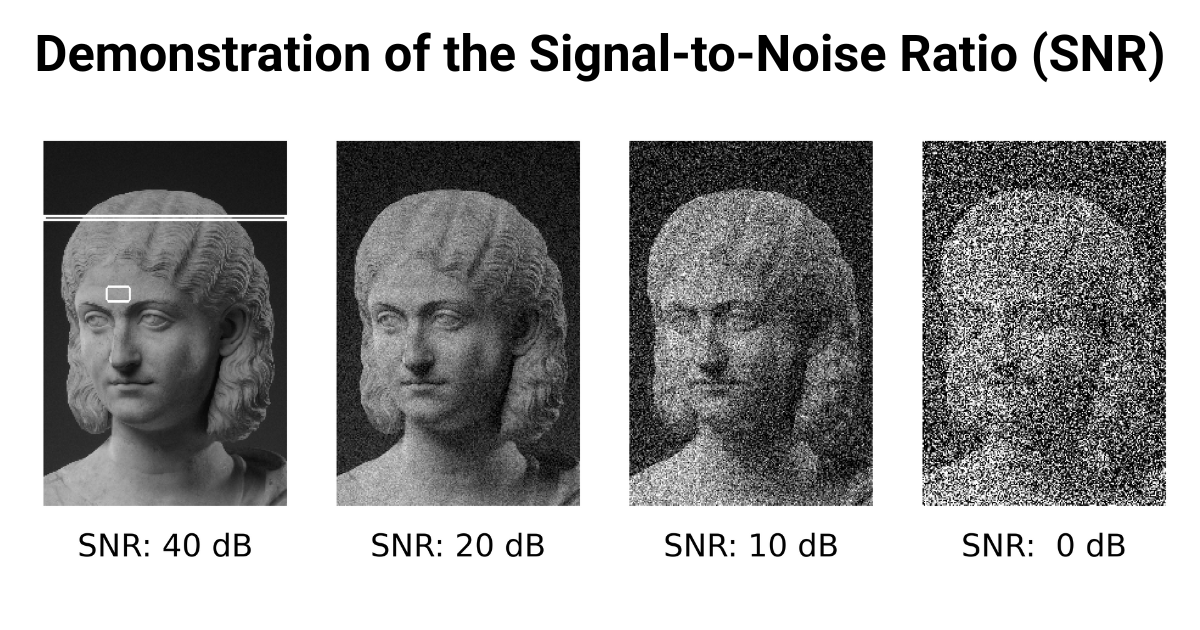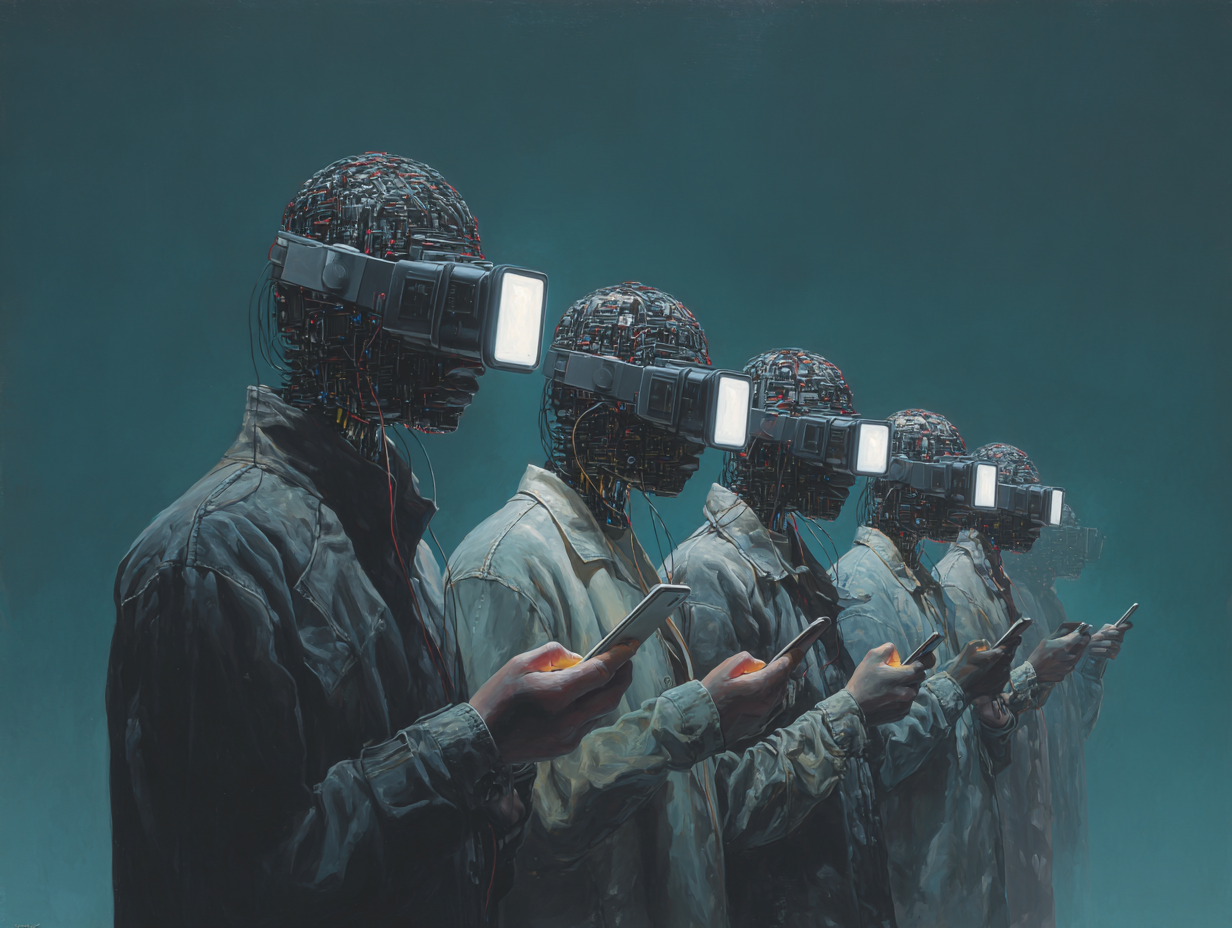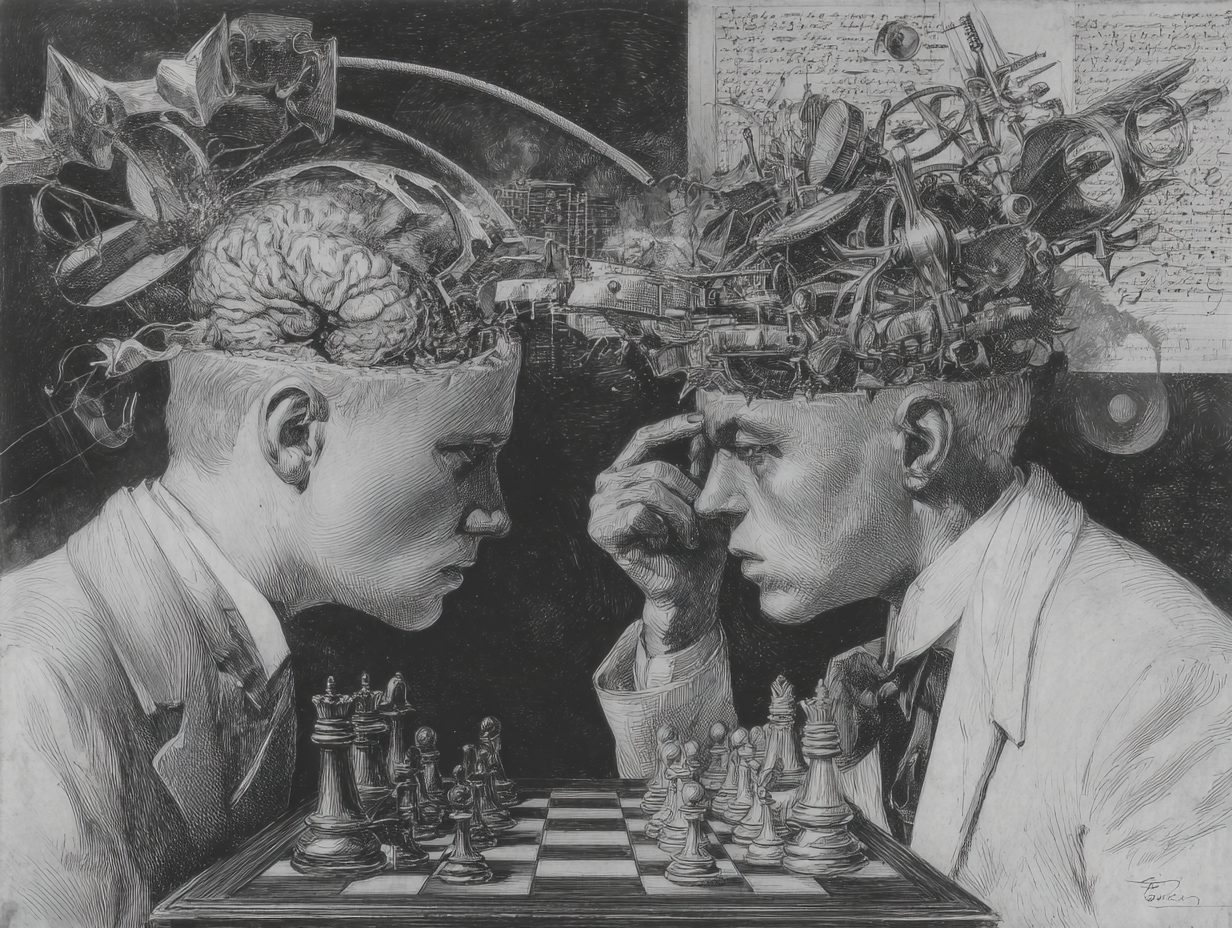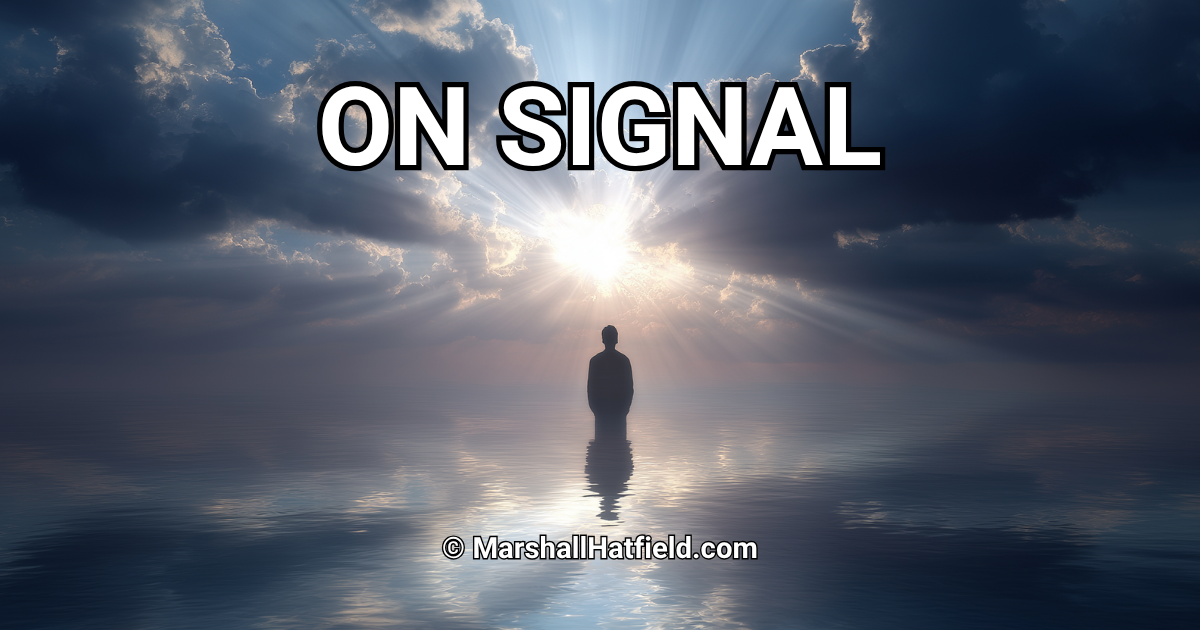
PART I. Learning to Recognize Signal
Have You Ever Been Blindsided?
Ever been struck by a sudden moment of clarity?
Ever received a piece of news that changed everything in an instant?
The poet, Homero Aridjis, once said:
“There are centuries in which nothing happens and years in which centuries pass.”
How can time be so relative?
How can a certain moment be so much more significant than the next?
How can life be transformed in an instant, while so much time can pass by unnoticed?
All these phenomenon share one common thread.
Namely:
Signal.
In high concentration.
There’s a reason we experience the world in ebbs & flows of experience density.
That’s what we’re going to be discussing here today:
- What is Signal?
- How does it work?
- Why does it matter?
- How can you recognize Signal?
- How do we filter the Signal from the Noise?
And ultimately:
- How is understanding Signal the key to living your destiny?

What Signal Actually Is (And What It's Not)
The Physics Foundation: Signal vs. Noise
To truly understand Signal, we need to contrast it with its distorting, dysfunctional evil twin: Noise.
Noise is what prevents the Signal from getting through.
Signal and Noise are actually defined terms in physics.
Signal is the meaningful information you’re trying to detect.
Noise is the random, unwanted variation that interferes with it.
[source]
This electrical reality serves as a powerful metaphor with much broader applications to life in general.
Imagine tuning a radio:
The static you hear when trying to tune into a station? Noise.
The music? That’s the Signal (literally).
Picture a police tip line:
Most calls are worthless leads. Gossip & hearsay. Noise.
But sometimes a case solving witness calls in. Signal
Or consider the 24×7 ADHD news cycle:
Daily headlines about celebrity drama and political theater? Mostly Noise.
Major world-changing events writing history in realtime? That’s Signal.
How about in your everyday relationships?
What people say is often Noise.
What they consistently do? That’s Signal.
Signal conveys a clear message.
Noise is everything that prevents that message from getting through.
🤓 Physics Nerd Out Session: The Signal-to-Noise Ratio

In physics, the Signal-to-Noise Ratio (SNR) tells you how much meaningful information cuts through the chaos.
- High SNR? Clarity. The Signal is coming through loud & clear.
- Low SNR? You’re drowning in static. You can barely recognize the Signal at all.
But here’s what most people miss:
Not all noise is created equal.
In both circuits and human life, noise has different flavors. Recognizing which one you’re up against makes all the difference.
Additive Noise: The Background Buzz
This is classic static. Ever-present, layered on top. Like trying to focus in a crowded café or think clearly with ten browser tabs screaming for attention. It’s the hum of ambient distraction: subtle, constant, numbing.
Modern form: Notification pings, Slack messages, open-office chatter, ambient anxiety.
Multiplicative Noise: The Signal Gets Warped
This one’s nastier. It doesn’t just mask the message – it corrupts it. You’re not missing what’s being said. You’re mishearing it entirely. Like trying to have a serious conversation when sleep-deprived, or decoding meaning through the fog of stress.
Modern form: Burnout-colored decisions, conversations hijacked by tone, your own thoughts turning against you.
Timing Noise: The Rhythm Breaker
Sometimes the content is fine, but the timing is off. A message sent too early or too late, an insight interrupted mid-thought, a critical idea lost in the chaos of bad timing. Like someone arriving “around 7” when precision mattered.
Modern form: Calendar chaos, Slack-driven schedule fragmentation, the inability to finish a thought before being pulled elsewhere.
👉 The key insight: You’re not just fighting distraction. You’re facing different species of distortion. Each one requires a different strategy.

If Noise Is the Background Static…
… Signal Is the Meaningful Message Breaking Through
Here’s why it matters. A lot.
Noise is everywhere.
It creeps into every system, from radio broadcasts to smoke signals to face-to-face conversations.
Noise is chaos. It’s the constant pull of entropy; it’s the background static of reality.
Noise is automatic. It’s effortless. It shows up even when you try to stop it.
Noise requires no intention, no skill, no purpose.
As a first principle:
Noise is what prevents you from receiving Signal.
And Signal is vital.
Signal is the messaging layer where meaning exists.
But Signal requires tuning in. It requires filtering through the Noise.
It requires recognition that you have in fact landed on Signal, and you’re not just being fooled by more Noise.
And Signal carries truth.
Truth is powerful.

Part II. The 10-100-1000 Year Test
Separating Signal From Noise With the Ultimate Filter: Time
Here’s the fastest way to separate Signal from Noise:
Ask what survives.
Not what’s popular. Not what’s trending. Not what venture capitalists are excited about this quarter.
What actually lasts when everything else burns down?
Time is the most brutal filter in existence. It destroys Noise with surgical precision.
What remains is Signal in its purest form.
Most people optimize for the next year. Smart people plan for the next decade.
Enlightened Signal-builders think in centuries.
The Framework
- 10 years: Will this matter when today’s trends are dead?
- 100 years: Will this outlast everyone involved in creating it?
- 1,000 years: Could this survive the collapse of civilization itself?
Each milestone tests a different kind of truth.
The 10-year filter kills everything tied to temporary conditions. The 100-year filter destroys institutions but preserves principles. The 1,000-year filter annihilates everything except what’s fundamentally indispensable.
Let’s see how it works.
The 10-Year Filter
Since this article is being written in 2025, let’s look back to 2015.
Remember what dominated headlines?
“Inevitable” trends and world events never materialized. Individuals & companies that seemed invincible have vanished or fallen from grace.
What survived: Stripe (2010) became invisible infrastructure powering internet commerce. Zoom (2011) evolved from niche tool to essential global platform. DoorDash (2013) survived brutal competition through execution and adaptation.
What died: Google+ (2011-2019) proved you can’t force social networks with resources alone. FTX (2019-2022) built a $32B empire on deception that collapsed in three years. Juicero (2013-2017) created a $400 solution to a problem that didn’t exist, and burned through $120M investor capital in <4 years.
The pattern: Rigid optimization for current conditions is a death sentence. Adaptable principles win.
The 100-Year Filter
What happens when we look back 100 years, to 1925?
Almost every company, government, and institution from that era is gone. Only 0.03% of Americans alive today were born then.
Even dominant empires that seemed like they’d last forever have been replaced multiple times over.
What survived: The Airplane (1903) evolved from the Wright Brothers’ twelve-second flight to modern jets. J.P. Morgan (1871) adapted across multiple financial paradigm shifts and economic collapses. The U.S. Constitution (1789) provided a flexible framework that survived massive social and technological change.
What died: Steam Locomotives (1804-1960s) dominated transportation for 160 years, then became totally obsolete. The British East India Company (1600-1874) ruled entire continents for 274 years with its own armies, then couldn’t adapt to modern governance. The Ottoman Empire (1299-1922) lasted 623 years across three continents before collapsing when it couldn’t evolve from agricultural empire to industrial nation-state.
The pattern: Organizations, their founders & visionaries, and everyone who participated in them will one day die. It is the principles that make them valuable & give them meaning that live on.
The 1,000-Year Filter
To really see the type of strong Signal concentration that can outlast whole civilizations:
Let’s go all the way back to 1025 AD.
The world was fractured and feudal. Most people never traveled more than a few miles from where they were born. Almost nothing from that era survived in its original form. Empires fell. Whole civilizations vanished.
What survived: Roman Aqueducts (312 BCE) were crucial to the development of one of the largest ancient civilizations, and some still function 2,300+ years later because they work with gravity and natural forces. The Pythagorean Theorem (~500 BCE) is still taught in every school 2,500+ years later, and enables all modern engineering. Arabic Numerals (700-1000 CE) still form the foundation of all mathematics & computing after 1,000+ years of global dominance.
What died: The Roman Empire (27 BCE – 476 CE) dominated for 500+ years, then collapsed completely with no successor. Egyptian Hieroglyphics (3200 BCE – 400 CE) were used for 3,600 years across one of history’s greatest civilizations, then died so completely nobody could read them until 1822. Carrier Pigeons (3000 BCE – 1900s CE) were humanity’s fastest long-distance communication method for 5,000 years, then the telegraph made them instantly obsolete, while today they’re completely extinct!
The pattern: What lasts isn’t impressive – it’s indispensable:
- Physical systems working with nature.
- Information systems revealing fundamental truth.
What survives the 1,000-Year Test reveals something so true about reality it transcends the civilization that created it.
Why It Matters: Condensing Time Into Signal
The 10-100-1000 Year Test isn’t about predicting the future.
It’s about seeing through bullshit today.
When someone pitches you an idea, a product, a principle:
Ask: Is this solving a temporary problem or revealing a permanent truth?
High Signal brings deep truth & meaning. It doesn’t just matter right now: it matters next decade, next century, potentially next millennium.
Noise distorts Signal. It lacks truth & depth. When the Signal becomes weak, it is much more likely to disappear (sooner than later).
Everything you build, believe, or transmit – the Test reveals its level of Signal.
And here’s what most people miss:
We’re living through the noisiest era in human history. The Signal-to-Noise Ratio has never been worse.
Which means the ability to recognize Signal has never been more valuable.
Let’s look at exactly what we’re up against.

PART III. We're Drowning In Endless Noise
This Is the Noisiest Era in Human History
We’re running Stone Age brains on Space Age technology.
Human cognitive capacity hasn’t evolved in millennia. The information environment has exploded.
The total amount of data created globally has exploded from 2 zettabytes in 2010 to 149 zettabytes in 2024 (a zettabyte is 1,000,000 terabytes). [source]
That’s a 7,450% increase in just 14 years.
We now generate more data every day than the number of detectable stars in the cosmos.
The Cold Hard Facts of Information Overload
- Americans check their phones 205 times per day – that’s once every 4.7 minutes during waking hours [source].
- The average smartphone user receives 46 push notifications daily [source], with teens getting hit with 240 notifications per day. [source]
- US adults now spend nearly 8 hours daily consuming digital media [source], compared to less than 3 hours watching traditional TV.
- The average person spends 2 hours and 21 minutes daily on social media alone [source].
To put that in perspective, in 1970, your information sources were:
- 3 TV channels,
- 1-2 local newspapers,
- and a few radio stations.
The result is predictable:
Overloaded by Noise, society’s Signal detection capabilities are flooded.
The algorithm optimizes for engagement. Your apps are engineered to be addictive.
And you can’t just turn it off.
🎈 FUN FACT VIDEO: The Jumping Jesus Phenomenon
Robert Anton Wilson, renowned author & humorous futurist, referred to this acceleration of Information as the Jumping Jesus Phenomenon:
A measurement system tracking the exponential acceleration of human knowledge, using 1 AD as the baseline “Jesus Unit” and calculating how the doubling periods of total human information shrink from millennia to decades to years. [Source]
Building on work from Alfred Korzybski (the creator of General Semantics), Wilson first observed that information was doubling at accelerating intervals.
Wilson quantified this measurement of all human knowledge starting in 1 AD as a Jesus Unit, “named for the celebrated philosopher born in that year.”
His calculations showed the doubling periods shrinking relentlessly: 1,500 years to reach 2 Jesus, 250 years to hit 4 Jesus, then only 150 years to 8 Jesus.
“By 1960, in only 10 years we had 32 Jesus, by 1967 we had 64 Jesus, and by 1970, 128 Jesus.”
The trajectory led to an obvious conclusion:
“A day will come when we will experience more change in an hour than we have experienced in the past twenty, thirty thousand years. A situation like that is unimaginable so we call it a singularity – a place where the normal rules of modeling break down.”
This was Wilson’s prescient assessment in the 1970s.
Think about how far we’ve come.
How many Jesus Units will we add in 2025?

The Age of Permanent Cognitive Rewiring
Personal, individualized “digital detox” solutions miss a fundamental reality:
Digital technology has altered human brain chemistry at the species level.
- Brain structure changes are measurable and persistent – MRI studies show reduced gray matter volume in areas controlling decision-making and impulse control [source]
- Dopamine pathways are permanently rewired – Heavy smartphone users develop “dopamine deficit states” requiring constant digital stimulation to feel normal:
- “Digital media activates the same part of our brains as drugs and alcohol, releasing dopamine. With repeated use, our brains adapt by downregulating dopamine transmission. With enough ongoing exposure, our brains enter a dopamine deficit state, characterised by depression, anxiety, insomnia, irritability and craving.” [source]
- Attention span degradation is neurologically embedded – The mere presence of a smartphone reduces cognitive capacity by 10%, even when turned off [source]
- Working memory capacity is structurally diminished – Digital multitasking physically shrinks the anterior cingulate cortex [source]
- Adolescent brain development is fundamentally altered – Teens who acquire phones earlier show permanent changes in reward processing systems [source]
But the real problem runs deeper than individual brain chemistry.
The Social Fabric Has Been Rewired Too
Even if you delete every app and throw your phone in a drawer, you’re still living in a civilization that operates on digital logic:
- Cultural communication patterns assume instant availability – Professional and social expectations now require 24/7 connectivity [source]
- Economic systems depend on digital participation – From banking to healthcare, basic life functions require smartphone access [source]
- Social relationships are mediated through digital platforms – Face-to-face interaction skills atrophy when the entire peer group communicates via screens [source]
- Information architecture favors digital-native thinking – Even physical spaces are designed around QR codes, app integration, and algorithmic optimization [source]
Digital rewiring isn’t just personal. It’s civilizational.
There is no “off switch” for a society that has been fundamentally changed by our technology usage.
While physiologically, homo sapiens are not all that different from our cave dwelling ancestors…
… Culturally we’ve all become cyborgs (to varying degrees).
You can’t just “throw out your TV.”
You can’t just smash your smartphone.
Pandora’s box is already opened.
‘Software is eating the world.’ – Marc Andreessen
And it’s already picked most of the flesh off the bones.

🤖 Resistance Is Futile 🤖
You’re not just fighting your smartphone, or Social Media, or streaming services.
You’re fighting the gravitational pull of an entire rewired civilization that has been fundamentally changed on a biological level (in ways we’re still just beginning to understand).
Children experience more excitement from video games than anything in the physical world.
Adults invest more emotional energy in their online personas than their real relationships.
For millions, the simulation has become more compelling than reality – and most don’t even realize it.
This is what Baudrillard referred to as hyperreality.
And it’s all too real.

Noise Oversaturation Is Accelerating
The global rewiring isn’t slowing down. It’s accelerating.
- Average human attention span dropped from 12 seconds to 8 seconds since 2000 – Microsoft study shows 33% decline in just two decades, less than a goldfish [source]
- Teen anxiety and depression rates doubled since smartphones became ubiquitous – Between 2010-2015, adolescent depressive symptoms increased 33%, with suicide rates for teen girls rising 65% [source]
- Most knowledge workers can’t focus for even two hours without interruption – Only 61% of workers manage 1-2 hours of daily deep work, with average interruptions every 4 minutes [source]
Every software update makes the systems more persuasive. Every new platform learns from the psychological weaknesses exposed by the previous ones.
The arms race between human cognition and technological manipulation escalates daily… and the machines are winning.
But you’re not defenseless.
There are proven systems you can use to clear the clutter and start living a life driven by Signal that cuts through the Noise.
Some solutions are new, built by researchers who understand the neuroscience of cognitive defense. Some are ancient, passed down through millennia and more relevant than ever.
In this hyperreal world, the only way to thrive is to actively resist the oversaturation of meaningless Noise. Then, and only then, can your authentic self shine through.

PART IV. The Battle for Control of Your Mind
Everyone Wants to Hijack Your Attention
Every action you take depends on one thing: where you aim your attention.
- Your brain receives approximately 11 million bits of information per second. [source]
- However, your conscious mind can only process about 40-50 bits per second. [source] Recent research suggests you might actually think at just 10 bits per second. [source]
- That means you’re consciously aware of just 0.0005% of the data bits your brain receives.
Every moment, your nervous system faces an impossible task: sift through floods of sensory data and extract only what matters for survival, decision-making, and action.
The difference between thriving and drowning in modern life comes down to one question:
Are you controlling this filter, or is it controlling you?
The Trillion Dollar Attention Capture Industry
Your brain evolved to detect rustling bushes that might contain predators, and where to find ripe fruit trees.
That same survival system kept your ancestors alive for millennia. Now billion-dollar companies employ teams of neuroscientists, behavioral economists, and addiction specialists to turn that life-saving mechanism against you.
First They Hijack Your Physical Senses: Vibration, Colors, Sounds
“Observers correctly separate relevant from irrelevant stimuli due to physical rather than semantic features.” [source]
They know your brain processes physical characteristics first – pitch, color, loudness, movement, location – before meaning, context, or logic. So every notification is engineered to trigger your ancient threat-detection systems:
- Red badges exploit danger recognition
- Vibration patterns bypass conscious filtering through physical touch
- Specific sound frequencies optimize for alertness response
- Flashing elements trigger predator-detection instincts
These aren’t accidents. They’re precision weapons designed to bypass your conscious decision-making and hijack your attention at the neurological level.
Then They Trap You In Cognitive Chaos With Addiction & Distraction
The result, unfortunately, is that we’re all living in permanent cognitive warfare.
Every time your attention gets pulled away, it takes an average of 23 minutes to fully refocus on your original task. [source]
But most people get interrupted every 11 minutes! [source]
This leaves us living in permanent partial attention, a state of consciousness that makes it exceedingly difficult to detect Signal.
Distraction is only half the picture.
Because a distracted mind is also much more susceptible to addiction.
Addiction is what gets you truly hooked into this sticky pattern:
Switching, scrolling, swiping, and over-stimulating.
This can make deep, focused attention feel boring & uncomfortable… putting you in the perfect mental state to just keep on scrolling (longer engagement = more ad dollars).
Tech platforms weaponize variable ratio reinforcement – the same psychological mechanism that makes gambling addictive:
Sometimes you get a reward, sometimes you don’t.
The unpredictability keeps you coming back, and your dopamine system gets hijacked to serve engagement metrics instead of your actual goals.
Hijacked Attention Dulls Your Signal Detection Potential
When your attention system is constantly triggered by artificial stimuli, you lose the ability to detect genuine Signal in your environment.
Manufactured noise prevents you from fully experiencing:
- Important conversations,
- Meaningful insights,
- Creative breakthroughs, and
- Authentic connection.
You become numb. Reactive instead of proactive. Responding instead of creating. Consuming instead of building.
This is not an accident!
This is the intended outcome of a trillion-dollar attention economy that profits from your cognitive chaos.
But here’s what makes this particularly insidious:
You don’t just lose the ability to detect Signal – you lose the ability to distinguish between what’s real and what’s simulation.
When the manufactured experiences become more compelling than reality itself, you are in the grips of hyperreality.
🤓 Philosophy Nerd Out Session: Baudrillard & Hyperreality

French philosopher Jean Baudrillard (1929-2007) predicted our current predicament with startling accuracy. His concept of “hyperreality” describes a condition where simulated experiences become more compelling and influential than reality itself.
Baudrillard defined hyperreality as “the generation by models of a real without origin or reality” [source] – essentially, when copies replace originals, and representations become more significant than what they’re meant to represent.
- “We live in a world where there is more and more information, and less and less meaning.” [source]
- “Hyperreality is the inability of consciousness to distinguish reality from a simulation of reality, especially in technologically advanced societies.” [source]
Baudrillard argued that modern media doesn’t just reflect reality – it constructs it:
“In the society of simulation, identities are constructed by the appropriation of images, and codes and models determine how individuals perceive themselves and relate to other people.
His postmodern universe is one of hyperreality in which entertainment, information, and communication technologies provide experiences more intense and involving than the scenes of banal everyday life, as well as the codes and models that structure everyday life.” [source]
This only becomes more apparent in the Social Media age, where individuals publish idealized versions of life that bear little resemblance to daily existence. Yet these simulations become the standards by which people measure their own existence [source].
Perhaps the most famous Hot Take from Baudrillard?
Claiming “The Gulf War did not take place” [source]
(Baudrillard’s “La Guerre du Golfe n’a pas eu lieu” also provided the premise for David Mamet’s masterpiece 1997 film, Wag the Dog.)
While he didn’t explicitly deny the physical conflict, instead he argued that media representations were so produced, filtered, and constructed that they created a hyperreal version more influential than the actual events on the ground.
Even senior military officials have admitted they were learning of events in real-time from CNN broadcasts (just like everyone else)!

PART V. Real Solutions That Actually Work
My Personal Obsession With Signal & Noise
My name is Marshall Hatfield – follower of Christ, entrepreneur, and Signal detector.
I’ll be honest: this isn’t just intellectual curiosity for me.
I’m obsessed with Signal because I need it to survive.
My brain doesn’t filter noise the way most people do.
When I encounter pure static: doom-scrolling feeds, overwhelming background chatter, or deliberate deception – I need to get away physically, or I lose my mind. It’s an intense, visceral reaction.
But that same sensitivity that makes Noise unbearable also makes Signal unmistakable for me.
When real Signal hits, clarity strikes like lightning. The world disappears. Which makes me, in a way, a Signal antenna.
Learning From Real-World Signal Testing Battlegrounds
My entrepreneurial career taught me to spot genuine value creation versus manufactured hype. I’ve been involved in both, and my BS meter is now a finely tuned instrument.
Real estate deal making taught me to recognize an actual opportunity versus padded numbers. I can sniff out a daisy chain or inflated pro forma in seconds.
Martial arts taught me that you really only know someone’s true level when you can test them on the mats. Sometimes the toughest killers are unassuming, and the scariest monsters are harmless.
But my deepest education came through consequences. I’ve learned to distinguish truth from lies because the cost of getting it wrong is brutal.
Let me show you what I’ve learned about what actually works.
Reclaiming Your Cognitive Sovereignty
Your brain’s filtering system isn’t broken:
It’s the most sophisticated information processor ever created.
The problem isn’t your neurology – it’s that you’ve been fighting a war without realizing you’re under attack.
Once you understand how the hijacking works, you can turn your filtering system back into the superpower it was designed to be.
Your Brain Has Two Main Superpowers: Attention & Focus
Every action you take – from drinking water to closing a deal – depends on one thing: where you focus your attention.
And when you think about it from a purely numerical standpoint, the data looks bleak:
- Your brain receives approximately 11 million bits of information per second. [source]
- However, your conscious mind can only process about 40-50 bits per second. [source]
- That means you’re consciously aware of just 0.0005% of the data bits it receives.
- Recent research suggests you might actually think at just 10 bits per second. [source]
However, this isn’t a limitation or handicap:
Your consciousness is the most advanced targeting & filtering system known to man.
Scientists describe attention as a bottleneck that restricts information flow – and that restriction is precisely what saves you from cognitive paralysis. [source] If not for your ability to pay attention & focus, you would be completely, cripplingly overwhelmed by stimuli.
This advanced cognitive filtering system boils down to two critical, interrelated functions:
- Attention: Determines what gets through your cognitive filters
- Focus: Determines how you process what gets through
When you begin to remember these key foundational ingredients to a healthy mind, you can reclaim your cognitive sovereignty using the very mechanisms others are trying to hijack.
Level-Up Your Attention & Focus Like the World's Most Elite Top Performers
The difference between average attention and elite-level focus isn’t talent – it’s training.
Military special forces, Olympic athletes, and precision marksmen all use scientifically-validated methods to develop attention capabilities that seem almost superhuman.
How Elite-Level Performance Actually Works
For professional archers, 80% of performance is determined by psychological factors, with only 20% coming from biomechanical skill. [source]
A Walter Reed study found that soldiers who practiced attention training scored 20% higher on weapons qualification and marksmanship under stress. [source]
These aren’t marginal improvements – they’re the difference between mission success and failure.
What’s most revealing, and perhaps counter-intuitive, is that these elite performers don’t rely on willpower or motivation to maintain heightened focus. Quite the opposite:
When practicing their craft, elite performers are actually powering down the prefrontal cortex (what neuroscientists call “transient hypofrontality”). [source]
By entering into what’s called a “Flow State,” peak performers experience a temporary downregulation of activity in key areas of the brain responsible for things like:
- Self-monitoring
- Time perception
- Inner dialogue
- Impulse control
- Abstract thinking
In short: the thinking brain powers down, and the doing brain takes over.
Let’s talk about how to tap into these, and other key frequencies, to maximize your own elite performance capabilities.
Proven Training Protocols for Elite Mental Performance
Brain Frequency Training
Superior attention operates on precise electrical frequencies. Alpha waves (8-13 Hz) represent optimal relaxed, sustained attention, while theta waves (4-8 Hz) indicate deeper focus states. [source]
Studies show that frontal theta activity directly correlates with sustained attention and distraction filtering. Military cohorts receiving frequency-based training showed significantly fewer performance lapses. [source]
How to implement: Listen to alpha binaural beats (10Hz) for 10-15 minutes during focused work sessions. Use headphones, block out background noise, and search on YouTube or your favorite music streaming apps for “alpha binaural beats 10Hz” to try it out.
Neurofeedback Training
Elite athletes use EEG feedback to train optimal brain frequencies. SMR training at 12-15 Hz improves accuracy in precision sports requiring sustained attention. [source]
How to implement: Consumer EEG devices like Muse provide real-time brainwave feedback. Start with 5-10 minute sessions focusing on calm, alert states.
Flow State Training
Psychologist Mihaly Csikszentmihalyi identified flow as complete absorption in challenging activities where “nothing else seems to matter.” [source]
During flow, brain wave activity shifts from anxious beta waves to smooth alpha waves, while the prefrontal cortex reduces activity, eliminating self-consciousness and time perception. [source]
This creates the “effortless concentration” that characterizes peak performance.
How to implement: Give your full attention to a challenging activity that both draws out your proven capabilities & still challenges you (a sport, musical instrument, or challenging hike). The goal is performing an activity that requires your full attention & focus without creating anxiety. 45-90 minute sessions work best.
Deep Work Protocols
Cal Newport defines deep work as “professional activities performed in a state of distraction-free concentration that push your cognitive capabilities to their limit.” [source]
Research shows that focused attention on specific tasks causes myelination of neural pathways, literally strengthening the brain circuits involved. [source]
How to implement: Schedule 1-4 hour uninterrupted blocks. Same time and place daily. Finish one task completely before switching. Don’t let anything distract you.
Military-Grade Mindfulness
Distance runners focus on finishing the next mile. Special forces focus exclusively on performing well for the next 5 minutes, then repeat. [source]
This prevents cognitive overload while maintaining tactical awareness.
How to implement: Set a 5-minute timer and commit to performing at your absolute best only until it rings. Reset and repeat.

PART VI. Biblical Discernment
A Time-Tested Manual for Signal Recognition
The neuroscience research we just explored isn’t new.
It’s confirmation.
Thousands of years before we had brain imaging technology, functional MRIs, or cognitive load theory, Scripture was already teaching systematic methods for distinguishing truth from deception. What modern science calls “Signal detection” and “cognitive filtering,” the Bible calls discernment – and it’s been stress-tested across millennia:
“Judge not according to the appearance, but judge righteous judgment.” – John 7:24
“And be not conformed to this world: but be ye transformed by the renewing of your mind, that ye may prove what is that good, and acceptable, and perfect, will of God.” – Romans 12:2
The wisdom of God is encoded into the fabric of reality itself (Signal).
However, the world is full of deceptive appearances, false teachers, and distractions.
That’s why – now, more than ever – it is crucial to empower & improve your discernment, your “righteous judgment.”
The Feedback Loop: Using Signal to Find More Signal
Here’s what makes biblical wisdom uniquely reliable: it never changes.
It’s a dense Signal that has survived far beyond the 1,000 Year Test.
And it’s still relevant to recognize & understand Signal arriving today.
While neuroscience research gets updated, revised, and sometimes overturned, Scripture provides enduring principles that have been tested by billions of people facing every conceivable form of deception & distraction across cultures and centuries.
When you’re developing Signal detection capabilities, you need frameworks that work under pressure, across contexts, and over time. This is practical reliability – concentrated Signal in its purest form.
The convergence isn’t coincidental. The God who designed your brain’s filtering system also provided an instruction manual for using it properly.
What Is Biblical Discernment
So what exactly does Scripture mean by discernment?
The Bible doesn’t treat discernment as abstract spiritual intuition or mystical feeling:
It is a clearly defined, practical method for interacting with the world.
It can be learned, practiced, and refined.
Let’s consider its key components.
“Try the Spirits & Prove All Things”
The Apostle John established the foundational principle:
Don’t believe everything you hear, even (especially?) from spiritual sources.
His approach was empirical testing, not passive acceptance:
“Beloved, believe not every spirit, but try the spirits whether they are of God: because many false prophets are gone out into the world.” – 1 John 4:1
To “try the spirits whether they are of God” is an active investigation. It requires attention, focus, and judgement.
Because even thousands of years ago, deceivers were already hijacking people’s cognitive operating systems. That’s why it was important for the apostles and even Old Testament prophets to encode these messages for the ages.
Paul expanded this principle beyond religious contexts. His instruction applies to every claim that seeks authority over your thinking:
“Prove all things; hold fast that which is good.” – 1 Thessalonians 5:21
“Prove all things” means submit every claim to rigorous examination. Are you dealing with Noise, or Signal? Test & prove everything, and only keep what holds up under spiritual discernment.
The Bereans demonstrated what this looks like in practice. When Paul himself preached to them, they didn’t just accept his message because he was an apostle:
“These were more noble than those in Thessalonica, in that they received the word with all readiness of mind, and searched the scriptures daily, whether those things were so.” – Acts 17:11
They literally fact-checked Paul the Apostle, perhaps the greatest evangelist of all time, against Scripture. This wasn’t disrespect; it was discernment. And Paul commended them for it. Discernment means to test & prove all worldly authorities against the Word.
“You Will Know Them By Their Fruits”
Jesus provided the most practical discernment method of all: outcome-based evaluation.
Don’t just listen to what people say – observe what they consistently produce:
“Beware of false prophets, which come to you in sheep’s clothing, but inwardly they are ravening wolves. Ye shall know them by their fruits.” – Matthew 7:15-16
“A good tree cannot bring forth evil fruit, neither can a corrupt tree bring forth good fruit… Wherefore by their fruits ye shall know them.” – Matthew 7:18-20
This is long-term pattern recognition.
It’s much easier to deliver a message that sounds good than it is to actually follow through on it:
- The relationship coach teaching about lasting love with multiple failed marriages.
- The political leader campaigning on integrity while enriching themselves through office.
- The spiritual teacher preaching humility while demanding constant praise and attention.
Signal consistently produces good fruit across time and circumstances. Noise might sound impressive initially, but the patterns always reveal the truth.
Biblical discernment operates on multiple levels simultaneously. It tests the source, the message, and the messenger. It evaluates both immediate claims and long-term outcomes. It combines systematic verification with practical wisdom.
This isn’t just spiritual advice – it’s cognitive methodology that works whether you’re evaluating religious teaching, political promises, business opportunities, or relationship decisions.
How Do You Build Discernment?
Biblical Meditation
“This book of the law shall not depart out of thy mouth; but thou shalt meditate therein day and night, that thou mayest observe to do according to all that is written therein: for then thou shalt make thy way prosperous, and then thou shalt have good success.” – Joshua 1:8
Biblical meditation isn’t emptying your mind – it’s filling it with signal-rich content and actively processing it.
Speaking & talking about the Word is great, but it’s also important to meditate and focus on it quietly, in your mind.
This continuous engagement trains your thinking patterns around truth rather than noise.
How to implement: Choose one verse daily. Spend 10-15 minutes asking: “What does this reveal about God’s character? How does this apply to my current challenges?”
Biblical Prayer
“But thou, when thou prayest, enter into thy closet, and when thou hast shut thy door, pray to thy Father which is in secret.” – Matthew 6:6
“Watch and pray, that ye enter not into temptation: the spirit indeed is willing, but the flesh is weak.” – Matthew 26:41
Prayer combines environmental design with sustained attention training.
Create sacred space, then maintain God-awareness while staying alert to spiritual threats.
This isn’t just asking God for things – it’s developing the habit of checking your thoughts and decisions against His truth throughout the day.
How to implement: Set 3-4 brief prayer moments throughout the day. Ask: “What am I being tempted to believe right now? What Signal am I missing?”
Biblical Fasting
“And I set my face unto the Lord God, to seek by prayer and supplications, with fasting, and sackcloth, and ashes.” – Daniel 9:3
“And when they had ordained them elders in every church, and had prayed with fasting, they commended them to the Lord, on whom they believed.” – Acts 14:23
Voluntary constraint sharpens your ability to say “no” to immediate impulses and “yes” to longer-term truth.
When you practice saying no to food, you strengthen the same mental muscles needed to say no to deceptive thoughts, false urgencies, and emotional reactions.
Even Jesus Christ fasted!
How to implement: Start with 12-24 hour fasts focused on specific decisions. Use hunger as a reminder to pray for discernment rather than react from emotion.

Exercising Discernment Daily
Single-Minded Focus
“Draw nigh to God, and he will draw nigh to you. Cleanse your hands, ye sinners; and purify your hearts, ye double minded.” – James 4:8
“A double minded man is unstable in all his ways.” – James 1:8
“The light of the body is the eye: if therefore thine eye be single, thy whole body shall be full of light.” – Matthew 6:22
Divided attention leads to compromised discernment.
Single-minded attention & focus is at the heart of your ability to discern Signal.
Practice giving full attention to one priority at a time.
When you’re trying to serve multiple masters simultaneously, you end up serving none of them well and making poor decisions across the board.
How to implement: When facing decisions, ask: “What am I trying to serve here?” Choose one master for that moment.
Self Examination
“And why beholdest thou the mote that is in thy brother’s eye, but considerest not the beam that is in thine own eye? Thou hypocrite, first cast out the beam out of thine own eye; and then shalt thou see clearly to cast out the mote out of thy brother’s eye.” – Matthew 7:3,5
“Examine yourselves, whether ye be in the faith; prove your own selves.” – 2 Corinthians 13:5
Before you can accurately discern external situations, you must first examine your own heart and motives.
Jesus teaches that internal clarity is prerequisite to external discernment – remove your own beam before helping others with their speck.
Regular self-examination & radical honesty reveals blind spots, hidden biases, and internal noise that clouds your judgment.
How to implement: Weekly self-assessment asking: “What beam might be in my own eye right now? What motives am I not acknowledging? Where might I be deceiving myself?”
Walking in the Spirit
“And be not conformed to this world: but be ye transformed by the renewing of your mind, that ye may prove what is that good, and acceptable, and perfect, will of God.” – Romans 12:2
“Set your affection on things above, not on things on the earth.” – Colossians 3:2
Walking in the Spirit means aligning your priorities with God’s eternal values rather than worldly temptations and pressures.
When your affections are set on heavenly things, you naturally develop resistance to the noise of materialism, status-seeking, and temporary pleasures that cloud spiritual discernment.
However, your flesh will naturally pull you back into worldly temptations, which means walking in the Spirit will require constant vigilance.
How to implement: Daily priority check: “Am I pursuing what profits the soul or what profits the world? Are my decisions driven by eternal values or temporary pressures?”

PART VII. What Survives When Everything Else Crumbles
Soul Architecture: Building From Something Deeper
After exploring Signal & practical ways to detect, learn from, create, and amplify it in your own life, we arrive at an important juncture:
You need to ask yourself some serious questions.
We all do.
Because, if Signal is the raw material of Truth, of Love, of the Divine… what else are you working toward?
The bigger questions are:
- What are you building that will last?
- What are you building that will outlast you?
- What will you leave behind to benefit future generations?
These are the types of questions that will lead you to examine your own personal Signal-to-Noise ratio, both in the moment, and along your entire life’s path, and to ask yourself:
- How much of your life is guided by Signal?
- How much of it is just passively riding along with the Noise?
Most importantly:
- Are you building from your Soul?
- Or from something more shallow?
Building a life emanating from your deepest, authentic Self Structure takes constant effort: attention, focus, and discernment.
This is what we refer to as soul architecture.
Learning From the Historical Record
Revisiting the 10-100-1000 Year Test
Remember the 10-100-1000 Year Test from Part I?
That wasn’t just a thought experiment.
It’s a lens for examining what actually survives when everything else crumbles… and we have millennia of evidence to prove it works.
Throughout history, we can see exactly what passed the test and what failed. We know which creations lasted a few years, which lasted decades or centuries, and which rare Signal stood the test of time for millennia.
We know what seemed permanent but vanished overnight, and what seemed fragile but proved antifragile.
The historical record is brutal, and brutally honest.
Time destroys the illusion of Noise with surgical precision while, revealing Signal in its purest form.
As Nassim Taleb observed in his study of antifragile systems:
“What survives must be good at serving some (mostly hidden) purpose that time can see but our eyes and logical faculties can’t capture… Recall the foundational asymmetry: the antifragile benefits from volatility and disorder, the fragile is harmed. Well, time is the same as disorder.”
So before we talk about building your own soul architecture – before we discuss what you’re constructing that will last – let’s look at what humanity has already built.
Let’s examine the full historical record.
What actually survived at each milestone? What seemed eternal but collapsed? And most importantly: what patterns emerge when you look at thousands of years of human creation?
This isn’t about memorizing dates or celebrating achievements.
It’s about understanding the fundamental principles that separate Signal from Noise across time.
Let’s go deep.
The 10-Year Filter: Building From Fundamentals
Remember Stripe, Zoom, and DoorDash versus Google+, FTX, and Juicero?
The 10-year filter reveals whether you’ve built from Signal or Noise at the most fundamental level. It’s the survival threshold. If you can’t pass this test, you won’t make it to 100 years or 1,000.
Three requirements emerge from what survived versus what died. Three soul architecture questions you must answer honestly.
1. Substance vs Hype
Are you building real value, or just narrative?
Stripe built infrastructure developers could trust. Juicero raised $120M for a juicer that squeezed packets you could squeeze by hand. Google+ had infinite resources but nobody wanted to use it.
Hype gets you funded and press. Substance survives contact with reality.
2. Agility vs Rigidity
Can you adapt when conditions change?
Zoom scaled from 10M to 300M users because the foundation was adaptable. FTX optimized for one moment and collapsed when it shifted. DoorDash evolved execution while maintaining core principles.
Rigidity feels like strength. But when you optimize too hard for current conditions, you become fragile.
3. Truth vs Deceit
Is your foundation honest, or theatrical?
DoorDash won through operational truth – the business model actually worked. FTX was pure theater that collapsed in days under scrutiny. Google+ performed the motions of a social network while missing the fundamental truth: nobody wanted to be there.
Truth is raw Signal. Deceit is Noise pretending to be Signal.
The Soul Architecture Check
These three tests work together. Substance gives you something real. Agility lets you evolve. Truth ensures the foundation won’t collapse. Without all three, you won’t survive a decade.
Strip away your story, your brand, your metrics – what’s actually there?
Most things don’t pass. The 10-year filter kills everything built on hype, rigidity, or deceit. But surviving 10 years is just the beginning. The next filter asks something harder: Can what you’ve built outlive you?
The 100-Year Filter: Building Beyond Yourself
Remember the Airplane, J.P. Morgan, and the U.S. Constitution versus Steam Locomotives, the British East India Company, and the Ottoman Empire?
The 100-year filter reveals whether you’ve built systems that can outlive their creators. It’s no longer about whether YOU can survive: it’s about whether what you built can transfer to others and evolve across generations.
Three requirements separate what lasts from what dies with its founders.
1. Principles vs Execution
Can your core insight evolve beyond current implementation?
The Airplane survived because flight principles (lift, thrust, control) could evolve from wood and fabric to carbon fiber and jet engines. Steam Locomotives died because the entire principle became obsolete – diesel and electric were fundamentally better.
Your execution will become outdated. The question is whether your core insight can survive that transition.
2. Structures vs People
Can your system transfer beyond its founders?
J.P. Morgan built roles and functions that worked regardless of who filled them. The U.S. Constitution created a framework that survived despite radically different leaders. The British East India Company and Ottoman Empire were inseparable from their specific people and power structures – when those fell, everything collapsed.
If your system requires YOU to function, it dies with you.
3. Fundamental vs Contextual
Is your principle addressing permanent reality or temporary conditions?
The Constitution addressed permanent governance needs. J.P. Morgan solved permanent capital allocation problems. The Ottoman Empire optimized for pre-industrial power dynamics. The British East India Company served mercantile colonialism.
When contexts change, contextual solutions die. Fundamental principles adapt.
The Soul Architecture Check
These three tests escalate beyond the 10-year filter. You need principles that transcend execution. You need structures that outlive people. You need to solve permanent problems, not temporary conditions.
Can what you’re building exist without you? Will the core insight survive when the implementation becomes obsolete?
Most organizations don’t make it 100 years. Founders die, industries shift, entire business models collapse. What survives has separated the eternal from the ephemeral. The next filter asks something even more extreme: Can it survive the collapse of civilization itself?
The 1,000-Year Filter: Building From Universal Truth
Remember Roman Aqueducts, the Pythagorean Theorem, and Arabic Numerals versus the Roman Empire, Egyptian Hieroglyphics, and Carrier Pigeons?
The 1,000-year filter reveals whether you’ve touched something fundamentally true about reality itself. It’s no longer about you, your organization, or even your civilization. It’s about whether what you discovered transcends the world that created it.
Three requirements separate what becomes eternal from what remains mortal.
1. Discovery vs Invention
Did you find what was already true, or create something new?
The Pythagorean Theorem described relationships that existed before humans. Arabic Numerals represented quantity in its most efficient form. Aqueducts used gravity – a force that predates civilization. The Roman Empire, Egyptian Hieroglyphics, and Carrier Pigeons were human constructions that required constant maintenance and cultural agreement.
Inventions can be replaced. Discoveries reveal what was always there.
2. Elegance vs Complexity
Does it use the minimum necessary, or require elaborate systems?
Water flows downhill. Triangles have fixed spatial relationships. Numbers represent quantity through position. That’s it – no additional complexity required. The Roman Empire needed armies, bureaucracies, and constant conquest. Hieroglyphics required cultural continuity and shared meaning. Carrier Pigeons needed breeding, training, and infrastructure.
Complexity creates dependencies. Elegance creates permanence.
3. Foundational vs Dependent
Does it stand on its own, or need external support?
Gravity is self-supporting. Mathematical relationships are self-evident once seen. Numerical representation is self-contained. Empires depend on power. Writing systems depend on cultural transmission. Communication methods depend on technological infrastructure.
What’s foundational survives anything. What’s dependent collapses when support fails.
The Soul Architecture Check
These three tests ask the ultimate question: Have you touched universal truth?
Not useful truth. Not adaptable truth. But truth so fundamental it would survive the collapse of everything around it.
This is the highest standard of Signal. Most human creation – even brilliant creation – doesn’t pass. But what does pass becomes immortal. It echoes across millennia because it reveals something so true about reality that no amount of time or change can diminish it. This is what it means to build from Signal at the deepest level. This is soul architecture in its purest form.

What Remains When It All Falls Away
This isn’t about productivity hacks or better work-life balance.
It’s not about building a sharper personal brand.
This is about what’s left when everything external gets stripped away.
When the markets crash. When the platforms vanish. When the applause dies.
When your health falters. When the roles you’ve played no longer fit.
What remains?
If you’ve built your life from borrowed materials – status, strategy, reputation – there won’t be much left.
You’ll realize most of what you thought was “yours” was just circumstantial – on loan from a world that’s moved on.
But if you’ve built from something deeper:
- From principles tested in fire,
- From purpose that doesn’t require an audience,
- From character shaped under pressure…
You’ll find that the most important parts of you remain intact.
Are you living from soul architecture?
Or success theater?
Your career is temporary. Your health is temporary.
Even your reputation, your wealth, your relationships – all fragile.
But the Signal you generate, the lives you touch, the tools you build, the character you embody:
That’s the permanent record.
That’s what survives.
The Construction Materials of a Life
Most people build their lives from borrowed materials:
- Other people’s opinions about success,
- Social pressures about acceptable pursuits,
- Fear-based decisions avoiding perceived danger,
- Reactive patterns triggered by external circumstances.
These materials create lives that feel unstable because they are unstable. When your foundation shifts with every trend, criticism, and economic cycle, you’re building on sand.
“And every one that heareth these sayings of mine, and doeth them not, shall be likened unto a foolish man, which built his house upon the sand:
And the rain descended, and the floods came, and the winds blew, and beat upon that house; and it fell: and great was the fall of it.” – Matthew 7:26-27
However, there is another option.
You can build from Signal instead of Noise.
You can choose to devote your life to fulfilling the deepest impulses emanating from your Soul, living the life God calls you to live:
- Building from internal conviction, not mimetic desire
- Following timeless principles, with all of history as a teacher
- Paying attention to details, while still able to focus on the big picture
- Striving every day to live a righteous, holy, spiritually rich life
The difference might not be visible from the outside looking in, but you’ll know. You’ll feel the difference when you start to build your life’s foundation on first principles & timeless truths.
This is the type of soul architecture you need to form the foundation & building materials of the life you’re meant to live.
“Therefore whosoever heareth these sayings of mine, and doeth them, I will liken him unto a wise man, which built his house upon a rock:
And the rain descended, and the floods came, and the winds blew, and beat upon that house; and it fell not: for it was founded upon a rock.” Matthew 7:24-25
Your Personal Signal-to-Noise Ratio
Every life generates both Signal and Noise.
Every moment, you’re building Signal or Noise.
You’re also receiving & deciphering Signal from Noise.
This ever-present, infinite 2-way data exchange is the nature of reality:
You can’t turn it off or opt out!
You’re both receiving & transmitting every second.
While we’ve devoted significant attention to identifying & receiving Signal:
Now let’s talk about the types of Signal and Noise each of us is putting into the world.
Creating Your Own Signal
You’re transmitting clean Signal when your actions serve God’s purposes through you. You are a vessel for something greater than yourself.
As we learned with the Flow State discussion, peak performance is actually about reducing prefrontal cortex activity. Your brain goes into “doing” mode instead of “thinking” mode, getting out of your own way for the best version of yourself to shine through.
When building & creating from pure Signal, you’re building from your higher purpose. It’s where your God gifted talents & traits and your greatest developed skills combine.
Transmitting Signal means building that which will survive, even when you’re gone:
- the solution that saves someone years of struggle,
- the child who thinks clearly because you taught them how,
- the system that serves people you’ll never meet.
Signal is true character: values that remain consistent under pressure, even when there’s a high cost, because it emanates from somewhere deeper than yourself.
Reducing Your Noise Output
You’re leaving a trail of Noise when your actions serve only your ego.
Noise is the natural state of the cosmos. it takes real effort to resist its ever-present gravitational pull. It seeps into every system like entropy – slow, subtle, and corrosive.
Noise dissipates as it goes. It might vanish in seconds – but it will definitely vanish once you’re gone. It doesn’t last because no one wants it. No one cares.
To reduce your Noise output, you need to avoid things like:
- Reactivity over intention
- Performing for validation instead of acting from conviction
- Chasing applause, not impact
- Cynicism disguised as intellect
- Speaking without listening
- Building without purpose
- Mimicking instead of originating
- Avoiding hard truths to stay comfortable
- Short-term, scattered thinking
- Superficial, shallow life strategies
Here’s the brutal question: How much of your life is actually Signal?
Not your resume. Not your metrics. Not your reputation.
How much of what you’re building really matters?
How much of your typical day – or year – is lost in Noise purgatory?
How many of your choices are shaped by external pressure instead of internal conviction?
Are you living your best life as your highest & best self?
The question isn’t whether you’re “successful.”
The question is whether you’re building from Signal or amplifying Noise.
And only you know the answer to that.
(Re)Building From the Foundation Up
Soul architecture starts with first principles:
What do you actually care about?
Not what looks good. Not what’s fashionable.
But what you would die for. What still matters when no one’s watching.
What are you uniquely positioned to create?
Not what gets applause – but what changes someone’s life.
What would be worth building anyway, even if no one ever said thank you?
What remains when everything else is stripped away?
When the metrics vanish – what still drives you to show up, to serve, to create?
These aren’t comfortable questions.
They force you to separate what you want from what you were told to want.
But they’re the only way to build a life that doesn’t collapse when things fall apart.
The Choice I Leave You With Here Today
Every day, you face countless micro-decisions about what to build your life from:
- Do you speak the truth – or say what’s expected?
- Do you follow real curiosity – or chase what’s strategically useful?
- Do you create to serve others – or to manage perception?
- Do you build relationships on shared truth – or shared utility?
- Do you stand by your values under pressure – even when it costs?
Each choice either builds Signal or spreads Noise.
Each either strengthens your foundation or leaves you in the sand at the mercy of shifting tides.
The real freedom?
It’s not money. It’s not status. It’s not success.
It’s the ability to live with meaning without needing permission or applause.
This is what it means to be a Signal-Builder in a world of Noise.
You’re not here to win the game.
You’re not here to collect trophies or approval.
You’re here to build from something deeper.
You’re here to create soul architecture, and contributions to this world that echo through the ages.
When you recognize this battle for your mind (and soul), you can reclaim & defend your sovereignty.
You can reclaim your attention, focus, and discernment.
You can move toward the pockets of Signal density.
You can build a life around your deepest purpose, creating artifacts that matter, relationships that endure, and systems that serve long after you’re gone.
This is the life of Signal.
Noise fades. Signal remains.
What are you building?

